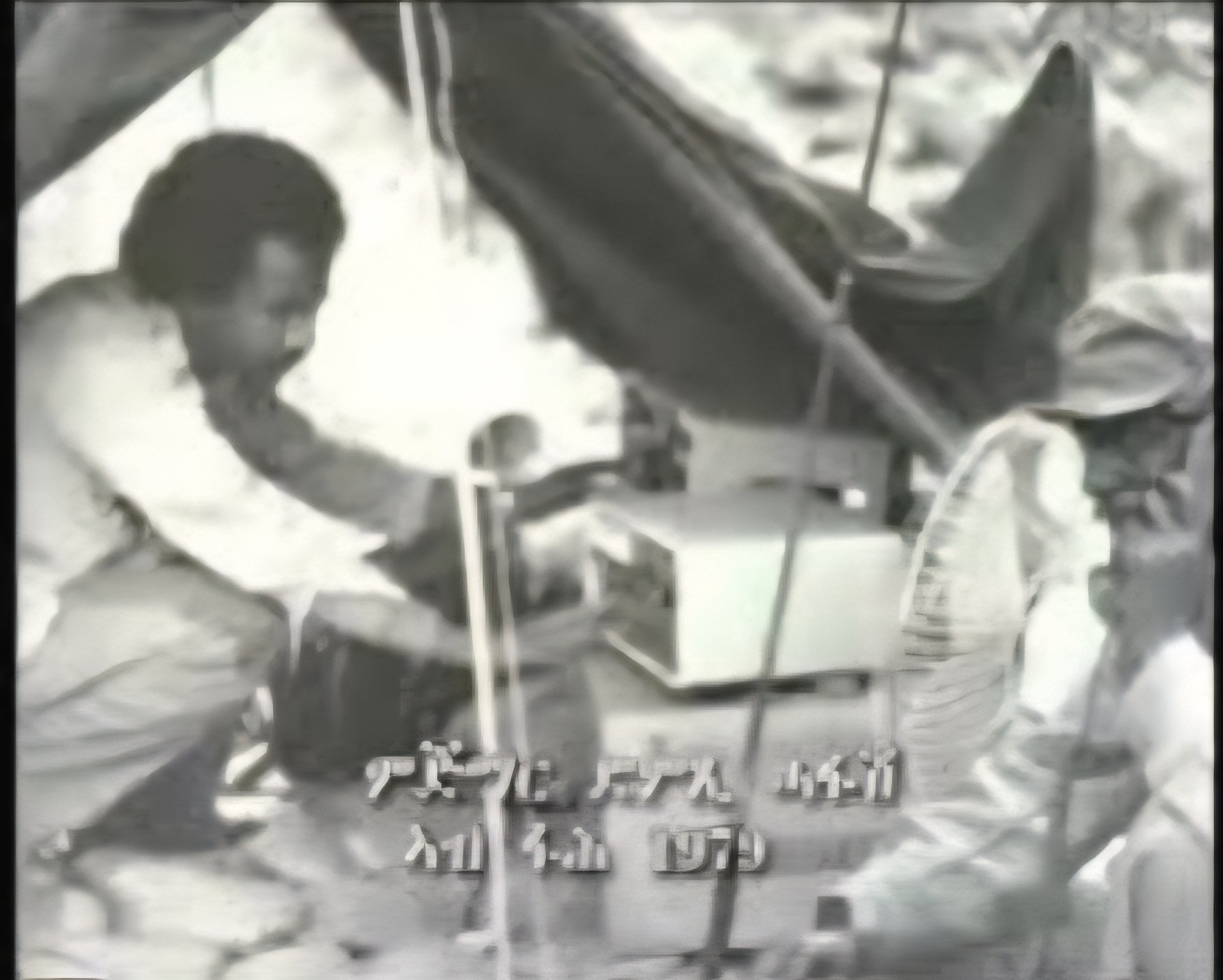By Sultan Mohammedsied Omer
July 21, 2025
Plato's allegory of the cave portrays mentally institutionalized prisoners, shackled at their neck and
ankles, held captive inside a cave while a bonfire burns behind them displaying in its shadow the delusions that shackle them from escaping the prison with no guard. The prisoners see nothing beyond the shadow on the wall created by the fire’s flickering reflection as they wither away in their idleness. They perceive this shadow as their sole reality and mistake this illusion for truth, believing it to be the entirety of existence.
The very-far-from-truth narratives that Ethiopian intellectuals constantly raise in connection with sea
ownership can be seen in the light of The Allegory of the Cave. The metaphor, in its simplest form, alludes to people often confusing shadows existing exclusively in their perceptions with reality, while reality awaits to be witnessed nearby. In uncannily similar deception, Ethiopian intellectuals vying to realize their dream of sea ownership, mislead their people by playing to their emotions on this unrealizable dream thereby keeping them in absolute ignorance.
The insatiable dream of these intellectuals is founded on fables and/or misleading information that they
unscrupulously swallowed and forced down the throats of the people that put great faith on their intellectuals’ wisdom. This parallels the prisoners' belief that the shadow is real. Like the prisoners, Ethiopian intellectuals' emphasis on reaching the sea to solve economic and geopolitical issues is a short-sighted gamble of great wager to the whole East-African region. The real world beyond the cave, with its challenges and opportunities, is ignored in the inflammatory campaign for port ownership.
Introduction
The purpose of this article is to advise Ethiopians to courageously challenge the false history and narratives that have been ingrained in their brains by various intellectuals and so-called nationalists. It is but a gentle reminder to understand the truth and revoke the fables and disinformation that have plunged their fertile land in the swamps of poverty for way too long. Studying history is imperative to understanding your roots, the past of your forefathers that has shaped your present and boosted morale. However, a narrative filled with distorted facts and utter lies based on myths and bedtime stories is not a morale-boosting tradition but rather a quicksand with serious consequences.
Successive Ethiopian regimes have worked and are working on making their country a cause of instability
and restlessness for Ethiopians as well as for the countries and peoples of the East African region. This is
not to seek a sea outlet, but because the leaders of this territory, since the time of emperor Menelik, led by expansionist and conquering aspirations, have embraced warmongering and hostile tendencies. This is even while the peoples of this region in general, and the Government of Eritrea in particular, have granted full access of ports utilization to the people and government of Ethiopia. The Eritrean peoples’ mentality of symbiotic existence and co-development was behind this generous gesture of peace.
The September 1991 edition of the “Harbegna” (i.e. “Patriot”) magazine clearly reflected this ideology while covering, broadly, cooperative partnerships. In an article titled
Interview with comrade Isaias Afwerki,
the magazine asked about future relations with neighboring countries. The then Secretary General of the People’s Front and the current President of Eritrea, Isaias Afwerki, responded
Based on this prudent principle, the Eritrean government closed shut the past dark history of oppression and massacres, without demanding any compensation or apology from the Ethiopian government and allowed Ethiopia to use Eritrean ports free of tariffs and customs duties in the early years of independence. Additionally, the government allowed Ethiopia to freely use the Assab oil refinery in order to meet domestic demand for refined oil.with Ethiopia and Sudan, for example, we can fight external pressures and conspiracies together, cooperate in capital investment through joint programs, use each other's resources to eradicate external dependence. Therefore, instead of just arranging our own, separate programs, it is undoubtedly better to work by charting programs with extensive and far-reaching implications. Our thinking must also broaden on par with this level. This may have previously existed only as an idea. However, I think it is important to have keen awareness and understanding of it now as it is heading towards becoming a reality.
This stance did not change even after the post-independence invasions that aimed at re-annexing Eritrea. On March 24, 2000, before the atmosphere of war had even slightly been diminished, Eritrea opened its Assab port for use by the international aid effort that was mobilized to feed the large section of the Ethiopian population that has been unable to extricate itself from famine for decades. This position continued even after the 2018 political changes in Ethiopia.
A 2024 strategy document released by the Ethiopian Ministry of Foreign Affairs’ Institute of Foreign Affairs (IFA) under the title of
confirmed that Eritrean ports are indeed open for Ethiopian use. This document clearly lays out Eritrea’s openness by stating thatThe Great Strategy of Two Waters
Myths and fables, Ethiopian intellectuals’ favorite weaponssince our relations normalized in 2018, the Eritrean side demonstrated a desire to resume port services. However, this is not sustainable. In summary, internal and external factors have constrained Ethiopia’s aspirations of port ownership.
These days, Ethiopian intellectuals in general and the prime minister in particular, on the basis of these
fallacies and sinister motivations, are planting seeds of hatred and protracted hostility that will deprive the Horn of Africa peace for generations to come. Armed with the evil slogan used to agitate for war
they have drafted thousands of recruits, trumpetingwhere there is hunger, the law is of no avail,
mendacious propaganda ad-nauseum to enable their expansionist political discourse garner the desired attention they so believe.
Successive Ethiopian regimes, including the current one in power, have developed a bad habit and natural disposition of laying blame on others for the country’s ills instead of recognizing, and trying to fix the problems they themselves created. As public grievances grow in the country, instead of trying to remedy the historical tensions they had created, they spend sunrise to sunset making the claim that Ethiopia's population-driven economic crisis was caused by the lack of a sea outlet that it
International law does not recognize this population size or economic "need" as a legitimate basis for claiming the territory of a sovereign state. If that was the case, it would open a Pandora's box of territorial disputes globally, undermining the fundamental principles of state sovereignty and territorial integrity. Therefore, their argument which relies on demographic pretext to justify territorial expansion is nothing short of a terribly erring daydream.had owned but lost.
The prime minister of Ethiopia has been busy describing his expansionist plans against Eritrea in various meetings. Subsequently, in his speech to the House of Representatives, in a provocative and blatant violation of the sovereignty of countries, he made contradictory statements to justify his dangerous plans, going so far as to audaciously claim that
When this official trumpet was blown, all of hisEthiopia has a natural right to have a direct gateway to the Red Sea, the Red Sea is Ethiopia’s natural border and that this is supported by historical, geographical, racial, ethnic and economic arguments. Moreover, for Ethiopia, not directly owning an outlet in the Red Sea is a matter of existence.
intellectuals with chameleon-like character withdrew from their hitherto trenches and immediately turned 180 degrees against the people and government of Eritrea. Suddenly discarding how they had been hailing Eritrea as their sole
friend during the hard times,
they unleashed venomous barrage of attacks against Eritrea’s unity and sovereignty.
These intellectuals bring up two interrelated geographical and demographic arguments to mollify this
old yet frequently revived expansionist ambition. Whenever this issue is raised in Eritrea, there is a
widespread view that all arguments made by Ethiopia are illegitimate and therefore it is pointless and a waste of time to entangle oneself in their ridiculous agenda. However, these false narratives are being disseminated by the Ethiopian state media networks and repetitively amplified by the regime’s supporters on the cheap belief that
lies become true if repeated often.
Hence, it is important to tirelessly repeat the obvious and objective truth to minimize their lies from misleading the entire Ethiopian population as well as other foreign entities. Their lies must be met with the truth to be halted
from contaminating the region and afar!
Going back in time, this country called Ethiopia reached the Red Sea coast for the first time in its history in 1952, after illegally annexing Eritrea under the guise of federation with the goading and significant support of foreign superpowers. For 39 years, until 1991, it violently controlled the coast in a reign of terror and widespread massacres. They did not settle in any city of Eritrea by the expressed invitation or will of the people of Eritrea but by the use of brute force. Eventually, the 39-year-old Ethiopian navy was destroyed by the small and poorly armed but brave navy of the Eritrean People’s Liberation Front.
"Through Eritrea, to the sea" John Spencer
In modern Ethiopian history, initiatives and conspiratorial schemes to attain a sea outlet began during the reign of emperor Haile Selassie. At that time, Ethiopia’s focus was on ports belonging to three different countries. The port of Zeila, of Somalia; port of Djibouti; and the Eritrean ports of Assab and Massawa. When emperor Haile Selassie set his eyes on these four ports, he was not trying to reclaim what he lost, rather he was vying to attain what he previously never had.
This is where the truth begins. The port of Zeila in Somalia was the primary focus of the emperor’s attention. However, the emperor’s adviser, John Spencer, in his personal memoir, had documented in detail (starting on page 141) that since the port was under British rule and Britain was a close ally of the United States, he thus counselled the emperor that pursuing the port of Zeila would be viewed as open hostility towards the Britain and therefore impossible to execute.
The emperor then turned his attention towards the port of Djibouti. Again, the advisor rendered the emperor's ambitions as unwinnable on the grounds that this would cause trouble with France, which ruled Djibouti and was one of the main allies of the United States. After that, it was the advisor and not the emperor that made another proposal.
Between 1936 and 1941, Eritrea, along with the Italian Somaliland made up the
and was for the first time being administered together with some parts of Ethiopia (the Italian-controlled parts of the country). After World War II ended with victory for the Allied forces and the defeat of Italy, Eritrea and Somaliland came under British military rule while Ethiopia regained its independence under emperor Haile Selassie.Italian East African Empire
Keenly aware of this prevailing circumstance, the emperor's adviser, John Spencer, took advantage of this
opening to turn the emperor’s attention to Eritrea to quench Ethiopia’s thirst for ports and sea outlet. Emperor Haile Selassie had concerns, on account of the responses he received on his ambition towards the first two countries. He asked if
since it was under the British military administration at the time. Whatever trick he had up his sleeve, John Spencer reassuringly dispelled the emperor’s concerns by saying,it was possible to annex Eritrea
Thereafter, emperor Haile Selassie, convinced by John Spencer’s advice, turned his full attention towards Eritrea for the realization of his ambitions.don’t worry about it, just leave it to us. The US government will prepare a plan to realize this goal.
Following the defeat of Italy, the Paris Peace Treaty of 1947 was to determine the fate of the Italian-controlled countries of Eritrea, Libya and Somalia. Article 23 of the Paris Peace Agreement required the Allied powers (USA, UK, France, Soviet Union) to decide the future of the Italian colonies, including Eritrea, within one year. If they could not agree, the matter was to be referred to the UN General Assembly.
The British proposed to partition Eritrea with the western parts going to Sudan while the highlands and coastal areas awarded to Ethiopia. The United States, for its part, proposed that Eritrea form a full union with Ethiopia. France proposed that Eritrea remain under the trusteeship of the Italian Administration while the Soviet Union, on their part, proposed to keep Eritrea under international trusteeship. Thus, they could not agree on the future of Eritrea. As they could not reach a common ground, the matter was referred to the UNGA in 1948 in accordance with previous agreement. It’s to be noted here that Ethiopia supported the British proposal of partition when full ownership seemed unlikely to succeed. Eventually, through the 1950 UNGA decisions, Libya and Somalia were granted independence while Eritrea was chained into a dubious “federation” with Ethiopia against the will of its people after a few years of exploitative and vandalizing rule by the British.
As the world emerged from the bitter times of World War II and was plunged into the era of the Cold War politics due to superpower competition, the US hatched and sponsored a so-called “federal act” with the dual aim of realizing imperial Ethiopia’s dream of annexing sea coast on one hand and guaranteeing US strategic and security interests in the Red Sea region on the other. Through subterfuge and secret dealings, this “federal” proposal received the required votes at the UNGA, notwithstanding its clear violation of international law and total disregard to the Eritrean people’s right of self-determination.
Article 10 of the UN Charter states that
Its recommendations are not enforceable and legally binding unless approved by the Security Council. Thatthe General Assembly of the United Nations shall have the power to make recommendations on international affairs, including the subject of decolonization.
is why the UNGA’s federal decision has gone down in history as an illegal and unfair decision that did not go through the proper procedures under the charter of the international organization. As an attempt to reconcile this glaring miscarriage of justice, it is claimed that the UNGA was accorded de facto empowerment to make such decision since the Allied Forces had agreed to accept and abide by its recommendations.
Recently declassified secret documents of the US State Department’s Office of the Historians laid bare the UN General Assembly’s justifications that required it to pass the US supported and sponsored federal resolution. The truth, as revealed by the State Department document entitled
notes that the federal resolution was passed primarily to achieve common US-Ethiopian goals and expand cooperation. In short, the main driver for the UN decision of federation was Cold War geopolitics rather than historic facts. This meant that support for Ethiopia,Disposition of the former Italian Colonies,
the strategic ally,
took precedence over Eritrea’s legitimate rights.
Federation Decision: Pre-annexation of Eritrea
The UN resolution on the federation of Eritrea with Ethiopia, which was passed to serve the interests of
Ethiopia and the United States, is primarily grounded on the myth of Ethiopian historic supremacy. It’s already received acceptance by many unscrupulous scholars and has been widely propagated in the media. As a result, with the aim of advancing their strategic interests, both of the competing superpowers camps championed Ethiopian causes in matters that involved Ethiopia and Eritrea. Also, work was done to have other African governments, based on the constructed narratives, frame the revolutionary movement for Eritrea's independence and self-determination as an unjustifiable struggle for secession.
Emperor Haileselassie worked hard on the diplomatic front to convince the vital importance of Eritrean ports for Ethiopia's economic sustainability and that his aspiration to annex Eritrea had legal and historical backing. Ironically, Ethiopia and UK at the same time also promoted the false narrative that Eritrea was not viable economically as an independent nation. But how is a non-viable Eritrea supposed to ensure the survival of Ethiopia? It was this contradiction that annoyed some countries at the UN Political Committee, so much so that some retorted if
Clearly, the UN did not consider Eritrea's unique colonial history of more than 50 years under Italy, nor the prevailing Eritrean nationalism. Hence, the biggest legal mistake the UN made in general was to pass the federation resolution knowing full well that Ethiopia's arguments were based on deep-rooted expansionist ambitions and had no legal or historical basis.it was fair for Ethiopia to have to carry such a burden.
During the federation period, however, Ethiopia's gradual abrogation of the federation and the failure of the United Nations to handle the matter properly and its refusal to listen to Eritrean objections of Ethiopia’s encroachments fueled Eritrean protests. To contain these protests, the emperor began to take brutal measures, leading the Eritrean youth to conclude that overcoming the harsh repression through peaceful protest was futile. As a result, they launched an armed struggle on September 1, 1961, before Ethiopia officially annexed Eritrea on November 14, 1962. Consequently, the unjust UN federal resolution, including its negative role during the revolution, have caused incalculable destruction of lives and property for both nations.
It should not be overlooked here that Abyssinia is the name of a collection of various nations, such as those of Shoa, Gondar, Wollo and Tigray, where the warriors of the same region who fought from time to time. Therefore, several rival kingdoms were seen to rise and fall in Abyssinia. None of the Abyssinian rulers who ruled these kingdoms at different times since the 8th century has, however, ever set foot at the shores of Eritrea’s Red Sea.
In 1910, when Menelik invaded and conquered vast areas, Abyssinia (modern-day Ethiopia) took its present-day geopolitical structure and international borders. Eritrea was already a country, founded in 1890, some 20 years ahead of Abyssinia. Exactly 10 years after Menelik's conquests, on September 28th, the kingdom of Abyssinia became the first African state to join the League of Nations upon its establishment in 1920. Later, the name of the country was changed to Ethiopian.
Right of self-determination: for independence or secession
The right to self-determination is an inviolable right that allows colonized peoples to determine their own future and is one of the civilized principles of the global society. This right includes the right of a people to form an independent state (political freedom), to join another government (union) or to have autonomy within a country. Secession, on the other hand, means secession from a country (a political unit) that has been known as a unified state. It means separating a part of the country from the larger state.
The people of Eritrea were denied the freedom they should have enjoyed in the mid-20th century when African countries were freed from the yoke of colonial rule in accordance to the UN Charter. Instead, their country was forcefully annexed by imperial Ethiopia with the support of superpower conspiracies. The Eritrean people waged an armed struggle for independence to exercise their long-delayed right to self-determination.
As the Eritrean revolution strengthened, new separatist movements emerged in the new political scenarios created with the end of the Cold War. At the time, various Western and Ethiopian intellectuals, in their campaign to secure their geostrategic interests and introduce the struggle as an isolationist movement, worked hard to promote that the Eritrean issue was a question of secession and not of self-determination. To this day, there are many who try to promote this false narrative. Mengistu Hailemariam, while delivering speeches at various military parades and meetings, used to convey slogans with embedded narrative construct such as
Gentay Wenbede Yidemesalu,
meaning
Separatist thieves will be destroyed.
As a result, the Eritrean struggle was misrepresented in the collective memory of Ethiopians as a separatist movement, not a question of self-determination. Generations were condemned to inherit this wrong memory.
Until the partitioning of Africa by European forces in the mid-19th century, the people of present-day Eritrea had long had a clear geographical coverage, ruled by ‘kings of the Sea’ (Bahre Negash or Bahre Negestat) and other chiefs, and had their own customary laws and traditions whose records still remain to date. This alone should enable it to be counted as a separate political unit. That is why, when the Italian government looked at the reality of Eritrea and its people, it made sure that the existing laws and regulations continued while the people preserved their culture. The series of foreign occupiers, that is the Turks and the Egyptians, that preceded Italian colonialism also laid the foundation for the political identity and interaction.
The present geographical structure of African countries took its final shape in the modern era of the partition of African countries by European powers. As part of this European scramble for Africa, Eritrea fell under Italian colonial rule in 1890. The continuous opposition and struggles of the Eritreans against the Italian colonialism led to the development of a unified sense of Eritrean nationalism among all the ethnic groups of Eritrea. As a result, Eritrean nationalism solidified as a political entity with a coherent political and social structure.
End Of Part One




